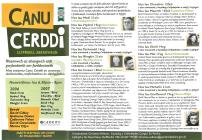Content can be downloaded for non-commercial purposes, such as for personal use or in educational resources.
For commercial purposes please contact the copyright holder directly.
Read more about the The Creative Archive Licence.
Description
Lede
Dr Bruce Moffett is a Fishguard-based independent scientist. He is a leading authority on bio-precipitation;
the study of clouds and how they form rain.
Story
Dr Moffett's work has been published widely in scientific journals, and he regularly holds tours and sessions in Fishguard with visitors of all ages. Here he outlines his work and the ground-breaking findings from research carried out on Fishguard's River Gwaun.
At school, I am sure, most of us were taught that rain is formed by cloud droplets merging, until they get big enough to fall to the ground. Not so...
For rain to fall, ice must first be formed. The surrounding water is then incorporated into the ice crystals which grow as they attract more and more water. This ice is what grows, not the liquid droplets. Eventually they are too large to stay aloft and fall to earth. The ice generally melts on the way down, so we get a lot of rain, rather than snow.
So far, so simple! BUT the water in clouds is pure, having been evaporated from oceans and rivers. Unbelievably it does not freeze anywhere near 0, but -36.5°C! It never gets that cold in clouds, so how is the rain produced?
There exists a very select group of tiny particles: rain making particles, ice making particles. These must be lofted into the clouds for the ice to form at temperatures warmer than -10°C. The vast majority of these particles are biological, from bacteria, pollen and fungi.
It was already known that there are a very low number of ice making particles in the oceans, but rivers had never been investigated. Roger Strawbridge (a local fisherman) and I set out to sample Fishguard Bay. The next day we sampled the River Gwaun.
Analysis of the marine samples confirmed the low number of rain/ice making particles in the oceans. However, the river samples (the first ever to be analysed) were a revelation, containing thousands of times more than the marine samples.
The scientific community were initially sceptical about results obtained from a tiny Welsh river. However similar results have recently been demonstrated in rivers worldwide (e.g., the Mississippi).
The discovery of huge numbers of freshwater rain making particles in Fishguard, has initiated international efforts to determine if ice making particles from rivers are more important for rainfall than those from the oceans.
This research, initiated in Pembrokeshire on the River Gwaun, has important implications for several aspects of climate change, including river management, rainfall prediction, and rainfall control.





Do you have information to add to this item? Please leave a comment
Comments (0)
You must be logged in to leave a comment